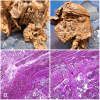Unusual presentation of placenta percreta with bladder involvement at 20 weeks: a case report
- PMID: 40787512
- PMCID: PMC12333818
- DOI: 10.1097/MS9.0000000000003476
Unusual presentation of placenta percreta with bladder involvement at 20 weeks: a case report
Abstract
Introduction and importance: Placenta percreta is a rare and severe form of placenta accreta spectrum (PAS), where the placenta invades beyond the myometrium, often involving adjacent structures such as the urinary bladder. The incidence of PAS is increasing, especially in countries with high cesarean section rates, and poses significant maternal risks, including life-threatening hemorrhage.
Case presentation: A 27-year-old gravida 6, para five patient at 20 weeks gestation presented with hematuria, oliguria, and overflow incontinence. Her medical history included three previous cesarean sections. Ultrasound and cystoscopy confirmed bladder invasion by the placenta, consistent with placenta percreta. A multidisciplinary team decided on a cesarean hysterectomy with partial cystectomy due to significant bleeding.
Clinical discussion: The management of placenta percreta with bladder involvement requires early diagnosis, careful planning, and timely intervention. This case highlights the importance of a multidisciplinary approach, with cesarean hysterectomy being the primary intervention. Preoperative strategies such as internal iliac artery occlusion can reduce blood loss and improve maternal outcomes. Bilateral internal iliac artery ligation was performed due to uncontrolled hemorrhage.
Conclusion: This case underscores the critical role of early detection and multidisciplinary management in optimizing outcomes for patients with placenta percreta, particularly those with bladder involvement. The increasing incidence of PAS necessitates awareness and preparedness to manage such high-risk pregnancies in clinical settings like Pakistan.
Keywords: bladder; hemorrhage; obstetric; placenta accreta; placenta percreta; pregnancy complications.
Copyright © 2025 The Author(s). Published by Wolters Kluwer Health, Inc.
Conflict of interest statement
Sponsorships or competing interests that may be relevant to content are disclosed at the end of this article. The authors declared no potential conflicts of interest concerning the research, authorship, and/or publication of this article.
Figures


Similar articles
-
Placenta Percreta Previa Crossing Surgical Frontiers.Cureus. 2025 May 29;17(5):e85028. doi: 10.7759/cureus.85028. eCollection 2025 May. Cureus. 2025. PMID: 40585613 Free PMC article.
-
Managing Placenta Accreta Spectrum: Diagnosis, Surgical Strategies, and Postoperative Care.Cureus. 2025 Jun 18;17(6):e86271. doi: 10.7759/cureus.86271. eCollection 2025 Jun. Cureus. 2025. PMID: 40688957 Free PMC article.
-
Urological outcomes and management of abnormal placental presentations: a retrospective study at a Lebanese center.Future Sci OA. 2025 Dec;11(1):2546235. doi: 10.1080/20565623.2025.2546235. Epub 2025 Aug 17. Future Sci OA. 2025. PMID: 40820430 Free PMC article.
-
Urological complications in women undergoing Cesarean section for placenta accreta spectrum disorders: systematic review and meta-analysis.Ultrasound Obstet Gynecol. 2023 Nov;62(5):633-643. doi: 10.1002/uog.26299. Ultrasound Obstet Gynecol. 2023. PMID: 37401769
-
Management of urinary stones by experts in stone disease (ESD 2025).Arch Ital Urol Androl. 2025 Jun 30;97(2):14085. doi: 10.4081/aiua.2025.14085. Epub 2025 Jun 30. Arch Ital Urol Androl. 2025. PMID: 40583613 Review.
References
-
- Wortman AC, Alexander JM. Placenta accreta, increta, and percreta. Obstet Gynecol Clin North Am 2013;40:137–54. - PubMed
-
- Wu S, Kocherginsky M, Hibbard JU. Abnormal placentation: twenty-year analysis. Am J Obstet Gynecol 2005;192:1458–61. - PubMed
-
- Nana P, Morfaw L, Fomulu J, et al. Placenta percreta occurring in the second trimester: a case report. Health Sci Dis 2013;11:1–4.
Publication types
LinkOut - more resources
Full Text Sources
